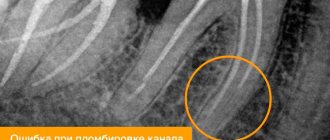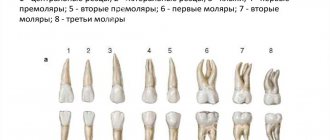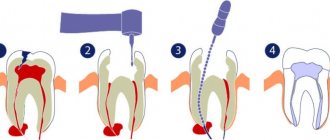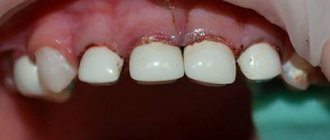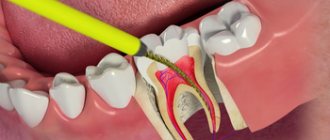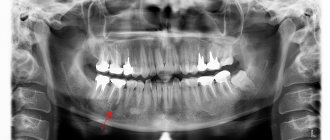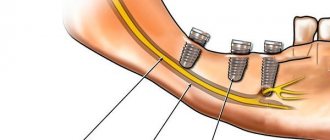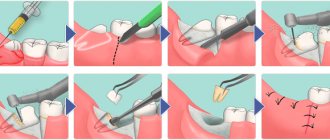Often, removal of the dental nerve, or pulp, is a necessary measure in the treatment of advanced dental pathologies. The procedure is quite complex, so it should only be performed by a qualified dentist with extensive practical experience.
To avoid medical errors and complications, contact the Mitino Dental Center. Our doctors know how to painlessly remove the nerve of a tooth and prevent its premature destruction.
Indications for nerve removal
- Caries has reached the pulp. Initially, caries appears on the enamel, then moves to dentin, then to the pulp. Inflammation increases: acute pain occurs. To eliminate the pain and save the tooth, you need to remove the nerve.
- Injuries of various types: impact, fracture, chip. With such mechanical impact, traumatic pulpitis develops. The integrity of the tooth is damaged, the infection penetrates into the pulp. Inflammation occurs and pain appears. Treatment involves removing the nerve.
- Retrograde infection. When inflammation occurs at the apex of the tooth root, it then spreads to the nerve.
- Orthopedic treatment. Before placing a crown, in some clinical cases it is necessary to remove the nerves. To avoid complications, a severely damaged tooth is first treated: the nerves are removed.
- Asymptomatic pulpitis (chronic). The patient does not have acute pain, but the nerve is infected. The patient's complaints may include mild pain in the past.
Cost of tooth nerve removal
The price of tooth nerve removal depends on the complexity of the clinical picture. The final cost is affected by:
- The degree of development of pulpitis. In the initial stages, partial removal of the nerve can be done. This operation will be cheaper.
- Number of channels. It is more difficult to treat a tooth with multiple irregularly shaped canals. Jewelry precision is required from a doctor. The difficulty of removing the nerve will increase the final price of the procedure.
- Method for removing the nerve of a tooth. The doctor chooses the appropriate method for removing the nerve of the tooth individually.
- Consumables used. We use high-quality consumables, so we can guarantee hermetically sealed canals.
- Number of doctor visits. The number of procedures required to remove the nerve and treat the canals depends on the complexity of the case.
If you have a toothache, sign up for a consultation at the Zuub.rf clinic. During the initial visit, the doctor will perform a visual examination, make a preliminary diagnosis and prescribe instrumental diagnostics. Based on the results of the examination, the doctor will tell you what procedures need to be performed and calculate the cost of the procedures.
What are the methods for removing a nerve?
- Amputation . This method is rarely used: mainly in pediatric dentistry. Its essence lies in the fact that the neurovascular bundle is partially removed. The pulp remains in the roots, and only the coronal part is removed. In adults, it is used in exceptional cases, when the doctor sees that the inflammation has affected only a small part of the nerve.
- Extirpation . The pulp is completely removed from the tooth. After removing the nerve, the canals are cleaned, washed, and filled.
Why is it necessary to remove a nerve?
Removal of the dental nerve is required in advanced inflammatory processes that affect both soft and hard tissue structures, including the pulp.
The most common reasons:
- periodontitis,
- pulpitis,
- benign neoplasm near the root,
- deep pulpal caries.
Depending on the type of pathological process and the size of the affected area, removal is carried out with partial preservation of the pulp or complete preservation from all canals. Amputation of part of the nerve is usually used for dental caries. In other cases, complete removal is usually necessary.
Sequence of treatment
- Diagnostics . After the doctor has examined you and collected your medical history, an X-ray is taken. This diagnosis allows you to evaluate the structure of the tooth and plan treatment. To see the full anatomy of the root canals, a computed tomography (CT) scan is performed - a 3D diagnostic that allows you to see all the structures of the tooth.
- Pain relief . Local infiltration or conduction anesthesia is performed. Before the injection, the gums are lubricated with an anesthetic gel so that the injection is not felt.
- Setting up insulation . Root canal work should be done in clean, dry conditions. For this purpose, rubber dam (insulation) is used. It is a latex plate that is placed on the tooth. Advantages of isolation: saliva and plaque do not enter the root canals. Medicines and solutions also do not flow into the patient’s mouth.
- Preparation of hard dental tissues . The doctor uses a drill to remove the destroyed tissue. To prevent overheating of the tooth, water flows from the tip. The doctor creates direct access to the root canals.
- Nerve removal . It is performed with thin sterile instruments similar to long needles. The doctor places an instrument into the root canal and removes the nerve. Machine rotary tools may also be used. This stage is completely painless, since anesthesia was previously performed.
- Mechanical and medicinal treatment of canals . The canals are washed with special antiseptic solutions and passed through with instruments. This allows you to completely remove the diseased nerve and relieve inflammation.
- Temporary filling . Root canal work is complex, so it is not always possible to treat a tooth in one visit. An anti-inflammatory paste is placed into the canals, a temporary filling is placed, and a further stage of treatment is planned.
For permanent restoration of the crown part of the tooth, ]esthetic dentistry[/anchor] will be required.
How long does the nerve removal procedure take?
The duration of the procedure depends on the degree of neglect of the pathology. On average, anesthesia takes about 5–15 minutes, and root canal treatment takes about 30–40 minutes. Sometimes medicine is placed into the cavity and closed with a temporary filling, and at the next visit it is replaced with a permanent one.
This method is rarely used, most often in cases of severe damage to multi-rooted teeth. For single-rooted individuals, one visit to the dental office is usually sufficient.
Important! Independent removal of a temporary filling is strictly prohibited. This leads to infection of the open canal, which is extremely dangerous not only for the oral cavity, but also for the entire body.
Contraindications
Doctors at the SDent aesthetic dentistry center collect all data about the patient’s condition before starting treatment. In the health questionnaire, the patient notes the characteristics of his body, and the doctor conducts a survey. Planned nerve removal is not performed if:
- high blood pressure, hypertensive crisis;
- first, third trimester of pregnancy (provided there is no acute pain);
- acute inflammatory diseases of the mucous membranes and facial skin;
- acute respiratory and viral diseases, etc.
General recommendations after treatment
- You can eat and drink immediately after treatment;
- Until the anesthesia wears off, you should not eat rough food;
- in the days following treatment on the side of the diseased tooth, do not chew rough, hard food;
- in some cases, anti-inflammatory drugs, painkillers, and oral baths are prescribed;
- If a temporary filling falls out, consult a doctor immediately;
- If pain occurs after placing a temporary filling, also consult a doctor immediately.
After the anesthesia wears off, the patient may feel discomfort in the area of the treated tooth. If pain, throbbing, or swelling occurs, you should consult a dentist.
Long-term consequences after treatment
Patients often experience complications after nerve removal. This is due to many factors: lack of diagnosis, poor quality treatment, incorrect diagnosis, etc. Main consequences:
- poor canal filling. A loose filling leads to the re-emergence of bacteria that extend beyond the tooth root. A cyst forms, due to which the tooth is often removed;
- tool fragments. The complex anatomy of the canals and low-quality instruments can lead to its failure.
- removal of material beyond the root apex. If the filling material is chosen incorrectly or there is too much of it, it extends beyond the root.
- Tooth perforation occurs due to aggressive processing.
To avoid such complications, doctors at the SDent clinic recommend contacting us for medical help, as we have a staff of highly qualified doctors, an equipped X-ray room and advanced equipment!
Stages of the dental nerve removal procedure
The doctor chooses a specific treatment plan depending on the clinical picture. Therefore, first you will undergo a complete examination. An x-ray is required. The image clearly shows the affected nerve, the location of the source of inflammation.
One of the symptoms of pulpitis is severe pain, which, if the disease is advanced, can innervate other areas of the jaw. Without an x-ray, it is impossible to determine exactly where the inflammation is and which tooth needs to be depulped. Also, using the image, the doctor assesses the condition of the pulp. This will help you decide whether the nerve will be removed completely or partially.
When the nerve of a tooth is partially removed, its coronal part is excised. In this case, the root part of the pulp is preserved. Partial resection allows you to keep the tooth alive, since the remaining part of the pulp will provide blood supply and nutrition to the tissue. Despite the fact that the method allows you to save part of the nerve, it is rarely used.
Most often, the nerve is removed completely. In case of severe inflammation, this method allows you to save the tooth. It can be restored and used as a support for prosthetics.
The nerve removal procedure will require several visits to the dentist. The procedure during each visit also includes several stages:
- Anesthesia. The nerve is removed under local anesthesia. The doctor injects an anesthetic and numbs the area of the gum where the diseased tooth is located. Anesthesia is selected individually to eliminate the risk of an allergic reaction during treatment. If you have an allergy to anesthetic drugs, tell your doctor. He will select a drug for you that is completely safe for your health. Thanks to the use of modern anesthesia, nerve removal in our clinic takes place with virtually no pain.
- Preparing the oral cavity. After the anesthesia has taken effect, the doctor isolates the surgical area using a rubber dam. This is necessary in order to prevent saliva from entering the operated area. Along with saliva, an infection can get into the wound, which can lead to a relapse. Careful isolation of the surgical area will help reduce possible risks.
- Treatment of dental canals. Before removing the nerve, all damaged tooth tissue must be carefully removed. To do this, it is drilled out using a drilling machine. The doctor will also open the pulp chamber.
- Nerve removal. Traditionally, nerve removal is done using a pulpoestrator. This instrument allows you to capture the pulp through the exposed pulp chamber. After the doctor grabs the nerve bundle, he will remove it from the dental canal. You can extract the nerve in another way: using a special miniature tool - a file. Visually, this tool looks like a long needle, but has a rough surface and therefore, in essence, is a miniature saw. Unlike a pulp extractor, the file allows you to carefully cut off the nerve bundle. Its use reduces the risk of damage to healthy tooth tissue. The doctor will decide which extraction method to choose based on the anatomical features and clinical picture of the patient. The entire procedure for removing the tooth nerve is controlled instrumentally, using an electronic apex locator device. It displays an image on the screen that clearly shows the position of the instrument. Using electronic devices, the dentist receives information about the number of dental canals, their shape, and length. Instrumental control helps the dentist perform the operation with high precision. This also reduces the risk of insufficient cleaning of the canals and re-infection.
- Treatment of dental canals. After extraction of the nerve of the tooth, it is necessary to treat the dental canals. First, they are cleaned to remove remnants of nervous tissue and foci of infection. Cleaning is done with files of different diameters. Cleaning begins with the use of the smallest diameter tool. During the procedure, the doctor performs rotational movements, gradually moving downward. To remove sawdust, the dental canal is washed with a syringe with an intracanal needle. Then the manipulation is repeated several more times using files of larger diameter.
- Temporary filling. The cleaned channels are expanded and washed with antiseptic solutions. To completely destroy the source of inflammation, a drug is placed into the cavity. After the procedure, a temporary filling is installed.
After completing the first stage of treatment, the doctor will set a date for re-examination and appointment. Before making a permanent filling after removing the nerve of a tooth, you need to make sure that the inflammation has completely stopped. To do this, another x-ray is taken. If the image shows that the nerve removal was successful, a permanent filling is made. The seal must be completely sealed. This will eliminate the risk of infection in the future.
Gutta-percha is used for filling. This is a rubber-like material that the doctor inserts into the canal cavity. Filling after nerve removal can be done in different ways:
- Thermafil and lateral condensation. These methods are used if there is good access to the operated tooth. Using special instruments, the doctor inserts a flexible pin-cone into the cavity.
- Thermogutta-percha. This is a more effective method that allows you to hermetically seal teeth with multiple and complex root canals. Thermogutta-percha is a moving mass, so it fills not only the main channel, but also microchannels, the smallest cracks and defects. It is difficult to achieve such tightness using traditional filling methods.
High-quality hermetic filling of the canals after removal of the nerve allows you to preserve the root of the tooth, so that it can be restored in the future. Filling material that fills all cavities becomes a reliable barrier against the penetration of pathogenic microflora, and this reduces the likelihood of re-infection.
